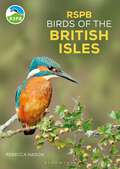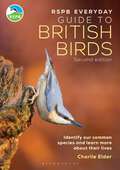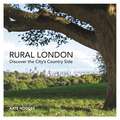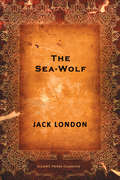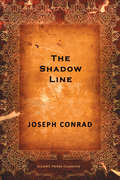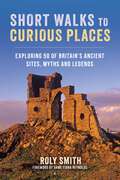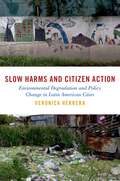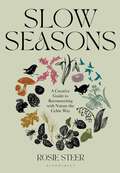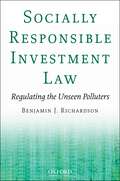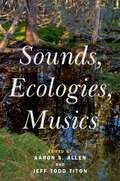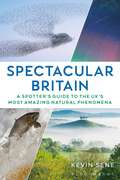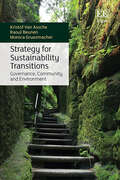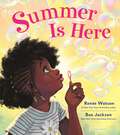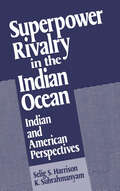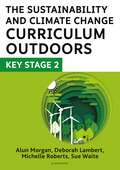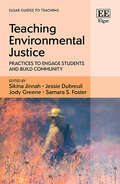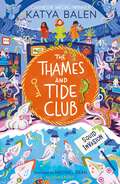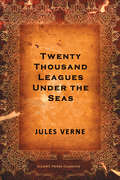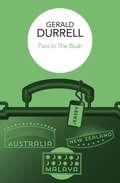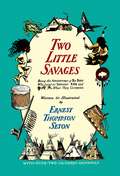- Table View
- List View
RSPB Birds of the British Isles (RSPB)
by Rebecca NasonA pocket-friendly photographic field guide to 290 birds of the British Isles.RSPB Birds of the British Isles features all regularly occurring birds in Britain, Ireland and the Isle of Man, covering familiar year-round species such as Wren and Sparrowhawk, winter and summer visitors including Purple Sandpiper and Arctic Tern, and a selection of rarer birds.Featuring concise identification text and expert photography, this photographic reference guide is suitable for both beginner and experienced birdwatchers alike. Species accounts include succinct descriptions of each bird's appearance, behaviour, calls and songs, and seasonal movements. The guide also identifies where to see each species and showcases this clearly through up-to-date distribution maps of the British Isles. Author and photographer Rebecca Nason has carefully chosen over 500 colour photographs to illuminate key identification points, including photos of male and female birds for sexually dimorphic species.Whether you are birdwatching in your garden or exploring wetlands, woodlands, mountains or coastlines, RSPB Birds of the British Isles is an ideal companion.
The RSPB Everyday Guide to British Birds: Identify our common species and learn more about their lives
by Charlie ElderA perfect companion for nature enthusiasts and birdwatching beginners, in a revised and updated edition. The RSPB Everyday Guide to British Birds describes 80 common and widespread species that we're most likely to come across in the British Isles and explains what makes each of them unique. Packed with fascinating facts and written in a friendly style, this RSPB guide is ideal for anyone who wants to identify and learn more about the birds they encounter, whether that's in their back garden or while they're out and about in urban and suburban settings or the British countryside.Alongside new photos to show both male and female birds where relevant, this second edition includes updates to species distribution and population numbers, as well as information on seasonal changes to British birds and how to attract birds to your garden. The guide also features updates to the UK's Red List species and a new section on birds that are flying high despite the current biodiversity crisis. From owls to finches and crows to woodpeckers, this RSPB guide is ideal for beginner and casual birdwatchers looking to discover more about British birds.
Rural London: Discover the City's Country Side
by Kate HodgesLondon is a wonderful city, but sometimes the hustle and bustle, noise and grime, can get too much and you feel the need for some peace and quiet, clean air and nature. But there’s no need to flee to the countryside, as London has so many surprisingly ‘rural’ areas and activities to offer. With everything from beautiful gardens and country walks, to cosy pubs and nature reserves, Rural London will help you to discover a very unexpected side of the capital city. Discover the best farmers markets, watch some morris dancing and visit a country show. Take a stroll around London’s villages, go bird-spotting and take some time out in a beautiful park. With colour photographs, short descriptions setting the scene and visiting details for each entry, this guide to rural London provides plenty of ideas and inspiration for places to visit and things to do, with something here for everyone.
The Sea-Wolf
by Jack LondonThe Sea-Wolf is a 1904 psychological adventure novel by American novelist Jack London. The book's protagonist, Humphrey van Weyden, is a literary critic who is a survivor of an ocean collision and who comes under the dominance of Wolf Larsen, the powerful and amoral sea captain who rescues him. London's intention in writing The Sea-Wolf was "an attack on (Nietzsche's) super-man philosophy."[8] Nietzsche and Schopenhauer are mentioned in the second sentence of the novel as the preferred reading of the friend Humphrey van Weyden visited before his shipwreck. The novel also contains references to Herbert Spencer in chapters 8, 10, Charles Darwin in chapters 5, 6, 10, 13, Omar Khayyám in chapters 11, 17, 26, Shakespeare in chapter 5, and John Milton in chapter 26. Like The Call of the Wild, The Sea Wolf tells the story of a soft, domesticated protagonist — in this novel's case an intellectual man named Humphrey van Weyden — forced to become tough and self-reliant by exposure to cruelty and brutality. The plot has some initial similarities to Captains Courageous by Rudyard Kipling in that they each have an idle, rich young man rescued from the sea and shanghaied into becoming a working sailor; however, the two stories differ widely in plot and moral tone.
The Shadow Line
by Joseph ConradThe Shadow-Line is a short novel based at sea by Joseph Conrad. The novella depicts the development of a young man upon taking a captaincy in the Orient, with the shadow line of the title representing the threshold of this development. The novella has often been cited as a metaphor of the First World War, given its timing and references to a long struggle, the importance of camaraderie, etc.
Short Walks to Curious Places: Exploring 50 of Britain's Ancient Sites, Myths and Legends
by Roly SmithEmbark on an extraordinary journey through the British countryside, leading to mysterious sites, ancient wonders and legendary landscapes to uncover 50 of the most intriguing walks in Britain. Discover the Green Chapel of Arthurian legend deep in the Staffordshire moorlands. Take a magical stroll through the fairytale forest of Wistman's Woods on Dartmoor. Marvel at the surreal rock formations of Brimham Rocks in Yorkshire, or spot the Hogwarts Express crossing the Glenfinnan Viaduct in the Scottish Highlands. With each walk ranging from two to eight miles in length and featuring beautiful photography, helpful directions and useful information, this book guarantees captivating experiences for walkers of all abilities, whether you're a casual stroller or seasoned hiker. Short Walks to Curious Places is your key to unlocking the secrets of the British countryside. With every step, you'll uncover the stories that shaped these extraordinary landscapes. Get ready to explore, discover and be enchanted by the wonders that lie just beyond the beaten path.
Slow Harms and Citizen Action: Environmental Degradation and Policy Change in Latin American Cities (Studies in Comparative Energy and Environmental Politics)
by Veronica HerreraEnvironmental degradation is not new, yet the impact of pollution on human health and wellbeing is growing. According to the World Health Organization, 12.6 million people die annually from living or working near toxic pollution, amounting to one-quarter of global deaths. Ninety-two percent of these deaths occur in middle or low-income countries, where the majority of the global population lives. For the millions of communities around the world where pollution is a slow moving, long-standing problem, residents born into toxic exposure often perceive pollution as part of the everyday landscape, particularly in low-resource settings. Local communities may also be both victims of pollution and complicit in perpetrating it themselves. When and how do people mobilize around slow harms? Moreover, when does citizen action around slow harms unlock policy action? In Slow Harms and Citizen Action, Veronica Herrera chronicles the struggle against toxic exposure in urban Latin America. Comparing advocacy movements for river pollution remediation in the capital regions of Argentina, Colombia, and Peru, Herrera explains how citizen-led efforts helped create environmental governance through networks that included impacted communities (bonding mobilization) and resourced allies (bridging mobilization). Through bonding and bridging mobilization, citizen advocacy for slow harms activated the state's regulatory capacity. Moreover, Herrera illustrates how the most successful environmental movements occurred in settings where established human rights movements had previously helped dismantle state-sponsored militarized violence. By unpacking human rights movements as thoroughfares for environmental activism, Slow Harms and Citizen Action sheds new light on the struggles for environmental justice in Latin America.
Slow Seasons: A Creative Guide to Reconnecting with Nature the Celtic Way
by Rosie Steer'A truly beautiful book. Rosie's writing makes me want to close my laptop, step outside, and appreciate the magic that each season brings' Jessica Elliot DennisonIn her late-twenties, feeling utterly overwhelmed by the pace of modern city life, Rosie Steer found solace in the traditions she had been brought up with, influenced by her Scottish roots, that celebrated nature and observed the small steady shifts in the seasons.The Celtic Wheel of the year is an ancient seasonal cycle that aligns with solar events – the solstices, equinoxes and their midpoints. For each mini-season, Rosie shares nature notes for what we can look out for as the days get warmer or cooler, the nights longer or shorter, alongside activities, things to make, flowers or fruit to forage, seasonal recipes to enjoy and a modern take on the traditional celebrations.As the Wheel turns towards Samhain on 31st October, we can look forward to foraging apples and berries to make Hedgerow jelly, watching the leaves turn golden, collecting pine cones for a Pine cone garland and celebrating pumpkin season with Pumpkin and root veg chilli and Chocolate cake with pumpkin curd.By slowing down and paying attention to the ebbs and flows of nature, we can find moments of calm whenever we need them.
Sounds, Ecologies, Musics
Sounds, Ecologies, Musics poses exciting challenges and provides fresh opportunities for scholars, scientists, environmental activists, musicians, and listeners to consider music and sound from ecological standpoints. Authors in Part I examine the natural and built environment and how music and sound are woven into it, how the environment enables music and sound, and how the natural and cultural production of music and sound in turn impact the environment. In Part II, contributors consider music and sound in relation to ecological knowledges that appear to conflict with, yet may be viewed as complementary to, Western science: traditional and Indigenous ecological and environmental knowledges. Part III features multidisciplinary and interdisciplinary approaches by scholars, scientists, and practitioners who probe the ecological imaginary regarding the complex ideas and contested keywords that characterize ecomusicology: sound, music, culture, society, environment, and nature. A common theme across the book is the idea of diverse ecologies. Once confined to the natural sciences, the word "ecology" is common today in the social sciences, humanities, and arts - yet its diverse uses have become imprecise and confusing. Engaging the conflicting and complementary meanings of "ecology" requires embracing a both/and approach. Diverse ecologies are illustrated in the methodological, terminological, and topical variety of the chapters as well as the contributors' choice of sources and their disciplinary backgrounds. In times of mounting human and planetary crises, Sounds, Ecologies, Musics challenges disciplinarity and broadens the interdisciplinary field of ecomusicologies. These theoretical and practical studies expand sonic, scholarly, and political activism from the diversity-equity-inclusion agenda of social justice to embrace the more diverse and inclusive agenda of ecocentric ecojustice.
Spectacular Britain: A spotter's guide to the UK’s most amazing natural phenomena
by Kevin SeneFrom the Northern Lights to whirling coastal birds, and sunken villages to the annual deer rut, the UK is home to some of the world's finest natural spectacles. With this guide and a little luck, you too can experience the magic of seeing something truly extraordinary.Start planning your spectacular year with the help of this practical guide to the UK's most magical natural phenomena. This guide shows you when and where to go, and how to maximise your chances of a sighting, as well as explaining why these amazing spectacles occur in the first place. Sections cover: - Space: meteor showers, eclipses and supermoons, Northern Lights - Weather: hidden currents, mountain waves, named winds - Tides: tidal bores, tidal races, low tide walks - Land: autumn colours, wildflower displays, rutting deer - Rivers and lakes: salmon runs, sunken villages, waterfall wonders - Coast: wheeling waterbirds, seabird cities, seal pupsEach spectacle is graded according to how easy it is to spot, and the author gives expert tips on achieving the best sighting. Scientific insights describe the astronomical, meteorological and ecological causes of events, which are brought to life through the stories of the people who know them best, from the glider pilots who ride mountain waves to the King's Guides who help people navigate the dangerous sands of Morecombe Bay. This is your starting point for some truly phenomenal adventures.
Strategy for Sustainability Transitions: Governance, Community and Environment
by Kristof Van Assche Raoul Beunen Monica GruezmacherIn this innovative work, Kristof Van Assche, Raoul Beunen and Monica Gruezmacher analyse the challenges and possibilities of sustainability transitions, presenting the dilemmas facing the path to more sustainable communities and societies, as well as proposing creative solutions. The authors deploy evolutionary governance theory as a conceptual framing for transition strategy, highlighting the importance of understanding governance and community strategy in any potential response to environmental crises.This timely book expertly draws on a wide range of disciplines and theories, in considering the limitations imposed by unpredictable dynamics of power, discourse and affect and the shifting boundaries of what is governable. The authors demonstrate the creative potential of both instabilities and rigidities in governance. Chapters detail the basics of evolutionary governance theory, developing and applying it to transition strategy by engaging in an accessible manner with post-structuralism, psychoanalysis, institutional economics, systems theory and critical management studies. In a clearly constructed theoretical narrative, the results of this engagement become clear, in a new understanding of the weight of the past on governance and community, the construction of temporality, change and strategic change, contextual notions of good governance, and how these affect major shifts towards sustainability.Strategy for Sustainability Transitions is an important addition to an ever-expanding and crucial field. Particularly relevant to practitioners and policy makers interested in sustainable development and environmental governance, it will greatly appeal to students and scholars of human geography, public policy and administration, environmental politics and planning and development studies.
Street Art Tel Aviv: In a Time of Transition
by Lord K2Distinctly unique, Tel Aviv's street art represents a wide spectrum of cultural backgrounds and aesthetic sensibilities. Echoing the uncertainty that permeates Israel's daily existence, it possesses a rawness and energy found in few modern cities. Through more than 250 images, 14 artist profiles, and comprehensive research, Street Art Tel Aviv introduces the reader to an alternative visual culture that has developed and thrived at a time when the citys building exteriors are plentiful, and living and workspaces are still available to emerging artists. At the turn of the 21st century, Tel Aviv's gritty streets, particularly those in southern industrial neighbourhoods, began to host a motley array of spectral faces, uncanny figures and curious characters. Random graffiti, from scrawls on the walls to stylized letters, made their way into largely vacant spaces. Artistic renderings of band-aids, hearts and eggplants evolved into iconic city images. Poetic expressions and musings from the personal to the collective surfaced increasingly on Tel Aviv's flat facades. And while much of what is painted directly onto the walls avoids commenting on the city's precarious political state, the stencils that continue to surface often stealthily in the dark alert us to the citys seemingly irresolvable, ever-present external and internal conflicts. Street Art Tel Aviv also gives entry into Tel Aviv's Central Bus Station, Israel's largest indoor urban art gallery. Showcasing murals in a diverse range of styles, painted directly onto its walls by local, national and international artists since 2013, it is a favourite site for street art and contemporary art enthusiasts. Herewith the opportunity to explore this vibrant city's visual landscape at a time of transition for both the city itself and for this new visual art genre.
Summer Is Here
by Ms Renée WatsonNew York Times bestselling creators Renée Watson and Bea Jackson offer a picture book ode to a picture-perfect summer day, from sunrise to sunset.Summer is here!No dark clouds in the sky, it's a perfect day for play. What joy will summer bring me today?Summer is finally here, and she's bringing the most perfect day! From sunup to sundown, there's so much to do on this lovely summer day. With summer comes fresh fruit, sweet and tangy, jump ropes for leaping and dancing, and friends at the pool swimming and floating. Summer brings family cookouts under shady trees, gardens overflowing, and the familiar song of the ice-cream truck. This beautiful ode to all the season's sensations follows one girl's perfect day in an exploration of joy, family, friendship, sunshine, and wonder.Her stars shimmer like spilled glitter across the sky. I whisper a wish and say goodbye to the day.I wish summer would stay.Renée Watson celebrates iconic childhood joys in this love letter to summer featuring bright, sun-drenched art from Bea Jackson.
Superpower Rivalry In The Indian Ocean: Indian And American Perspectives
by Selig S. Harrison K. SubrahmanyamThe Sustainability and Climate Change Curriculum Outdoors: Quality curriculum-linked outdoor education for pupils aged 7-11
by Deborah Lambert Sue Waite Michelle Roberts Alun MorganPromoting the inclusion of climate change and sustainability issues within the primary curriculum, this cutting-edge guide provides age-appropriate activities, curriculum links and opportunities for progression in knowledge and skills across lower and upper KS2.Designed to bring contemporary issues to life, the set of progressions include engaging and detailed lesson plans based around the Science National Curriculum throughout KS2. The book introduces essential curriculum concepts and teaches species identification, showing pupils how to encourage care and action for the natural world through outdoor activities linked to key curriculum goals. It demonstrates ways to progress children's learning through leadership in a model science curriculum and by the reformation of their own school grounds. Situating this teaching outside the classroom ensures that the developing concepts and knowledge are grounded in the real world, and being outdoors also has huge benefits for children's mental health and wellbeing. The guidance and templates for development planning are underpinned by current research, while vivid case studies bring these ideas to life.
Teaching Environmental Justice: Practices to Engage Students and Build Community (Elgar Guides to Teaching)
This ground-breaking book presents interdisciplinary educators with classroom tools and strategies to integrate environmental justice into their courses. Providing accessible, flexible, and evidence-based pedagogical approaches designed by a multidisciplinary team of scholars, it centers equity and justice in student learning and course design. It further presents a model for community-based faculty development that can communicate those pedagogical approaches across disciplines.Key Features:Reflection on how to teach inclusively across disciplines, with a focus on community-based faculty development.Presentation of a blend of insights from diverse disciplines, including art, astronomy, ecology, economics, history, political science, and online education.A focus on how to stimulate student engagement to improve students’ empirical and conceptual understanding of environmental politics.Detailed instructions for both introductory and more advanced active learning assignments and classroom activities, including guidance on how to manage common challenges and adapt activities to specific learning environments, particularly online formatsProviding detailed instructions and reflections on teaching effectively and inclusively, Teaching Environmental Justice will be an invaluable resource for faculty and graduate students teaching modules in environmental justice in courses across disciplines. It will also be essential reading for researchers of teaching and learning seeking insight into cutting-edge classroom practices that center equity and justice in student learning.
Termites and heritage buildings: A study in integrated pest management
by Brian RidoutThe last overview of termites for the non-specialist was published several decades ago and in the intervening years, both knowledge, and the termites themselves have moved on. A 27-year eradication effort for one termite infestation in Devon has shown that UK structures are becoming vulnerable as the climate changes and also that extermination of a colony can be difficult even when there are no other termites waiting to invade. Heritage buildings often present even more problems. Survey work and treatments may be complicated by structural and material complexity overlain with a requirement to retain as much undisturbed and original fabric as possible. There will be concealed cavities not inspected, and inserted barriers, both chemical and physical, will inevitably be incomplete. This study discusses the modifiable environmental parameters that govern termite activity and offers a resume of the baits and chemical treatments that have been developed so that the most appropriate can be selected where necessary. It is primarily intended for those involved in conservation, both in the UK and elsewhere, who commonly have limited resources. It is hoped that it will also be of use to architects, surveyors and others with an interest in Heritage structures.
The Thames and Tide Club: Squid Invasion
by Katya BalenThe mudlarkers of the Thames and Tide Club are about to face Squidmageddon in a funny and fast-paced adventure for young treasure hunters. When the director of the mudlarking museum goes on holiday for a week, he leaves three members of the Thames and Tide Club – Clem, Zara and Ash – in charge. They're determined that nothing will go wrong on their watch, but they haven't planned on an invasion of squid who will stop at nothing to take over the world … Join the club and dig for treasure in the wildest adventure you could imagine!
Travels in the Interior of America
by John BradburyInteresting notes about the country in early times.
Twenty Thousand Leagues Under the Seas: An Underwater Tour of the World
by Jules Verne F. P. WalterTwenty Thousand Leagues Under the Sea: A Tour of the Underwater World is a classic science fiction adventure novel by French writer Jules Verne published in 1870. While investigating reports of a sea monster off the coast of New York, Professor Pierre Aronnax instead discovers adventure in the depths of the ocean with Captain Nemo and the crew of the submarine Nautilus.
Two in the Bush (El\libro De Bolsillo Ser.)
by Gerald DurrellTwo in the Bush is a record of the six-month journey which took Gerald Durrell, his wife Jacquie, and two cameramen through New Zealand, Australia and Malaya. The object was, first, to see what was being done about the conservation of wild life in these countries, and, secondly, to make a series of television films for the BBC. They were introduced to many rare and remarkable animals – Royal Albatrosses, Tuataras, Duck-Billed Platypuses, Flying Lizards and Long-Nosed Bandicoots, as well as to some equally unusual humans. Anyone who has read The Overloaded Ark, The Bafut Beagles or The Whispering Land will have enjoyed Gerald Durrell’s enthusiastic adventuring and his delight in the absurdity of the situations in which he finds himself. His observation of animal – and human – behaviour is always informative and often hilarious. ‘Delightfully readable and often very funny.’ Daily Mail ‘An account of Gerald Durrell’s tour of New Zealand, Australia and Malaya in search of rarities . . . Easy to read, difficult to put down, with many vivid sidelights on the human side of the expedition. This absorbing narrative reveals the ardours, ironies and disappointments, the organizational miracles and the hilarious human mishaps . . .’ Maurice Wiggin, Sunday Times ‘Mr Durrell has the knack of writing about animals and their antics with tremendous affection and enthusiasm, but without sentimentality.’ Sunday Telegraph ‘Will delight his fans and armchair naturalists everywhere.’ Evening Standard
Two Little Savages: Being the Adventures of Two Boys Who Lived as Indians and What They Learned
by Ernest Thompson SetonThis is one of the great classics of nature and boyhood by one of America's foremost nature experts. It presents a vast range of woodlore in the most palatable of forms, a genuinely delightful story. It will provide many hours of good reading for any child who likes the out-of-doors, and will teach him or her many interesting facts of nature, as well as a number of practical skills. It will be sure to awaken an interest in the outdoor world in any youngster who has not yet discovered the fascination of nature.The story concerns two farm boys who build a teepee in the woods and persuade the grownups to let them live in it for a month. During that time they learn to prepare their own food, build a fire without matches, use an axe expertly, make a bed out of boughs; they learn how to "smudge" mosquitoes, how to get clear water from a muddy pond, how to build a dam, how to know the stars, how to find their way when they get lost; how to tell the direction of the wind, blaze a trail, distinguish animal tracks, protect themselves from wild animals; how to use Indian signals, make moccasins, bows and arrows, Indian drums and war bonnets; how to know the trees and plants, and how to make dyes from plants and herbs. They learn all about the habits of various birds and animals, how they get their food, who their enemies are and how they protect themselves from them.Most of this information is not generally available in books, and could be gained otherwise only by years of life and experience in suitable surroundings. Yet Mr. Thompson Seton explains it so vividly and fully, with so many clear, marginal illustrations through the book, that the reader will finish "Two Little Savages" with an enviable knowledge of trees, plants, wild-life, woodlore, Indian crafts and arts, and survival information for the wilds. All of this is presented through a lively narrative that has as its heroes two real boys, typically curious about everything in the world around them, eager to outdo each other in every kind of endeavor. The exciting adventures that befall them during their stay in the woods are just the sort of thing that will keep a young reader enthralled and will stimulate his or her imagination at every turn.
